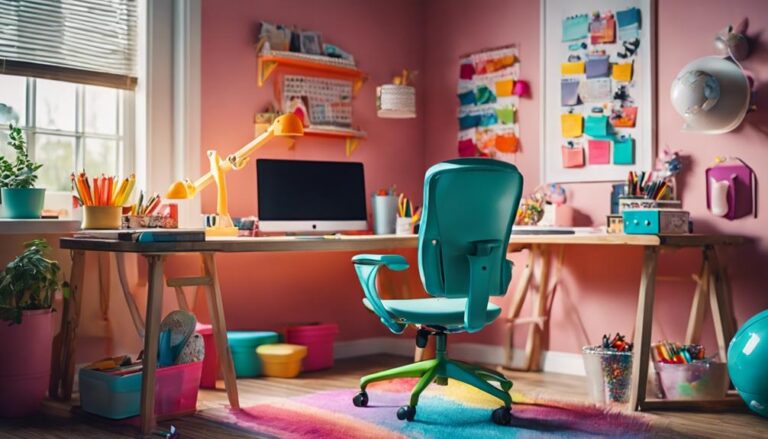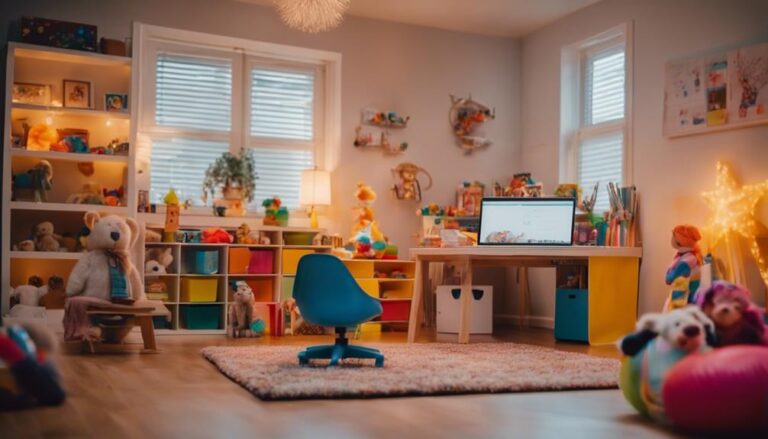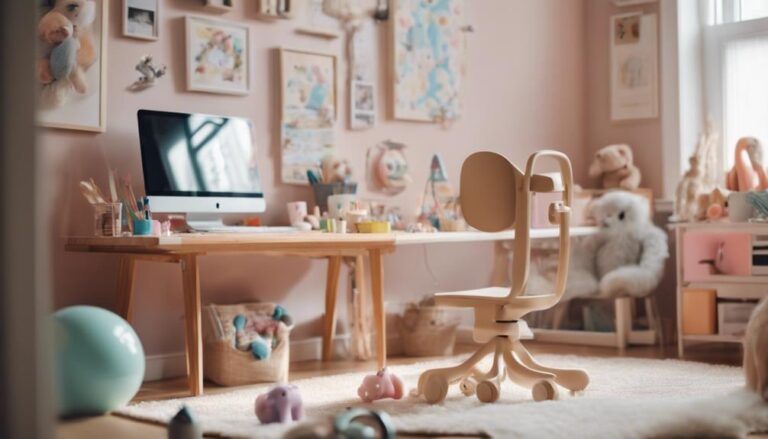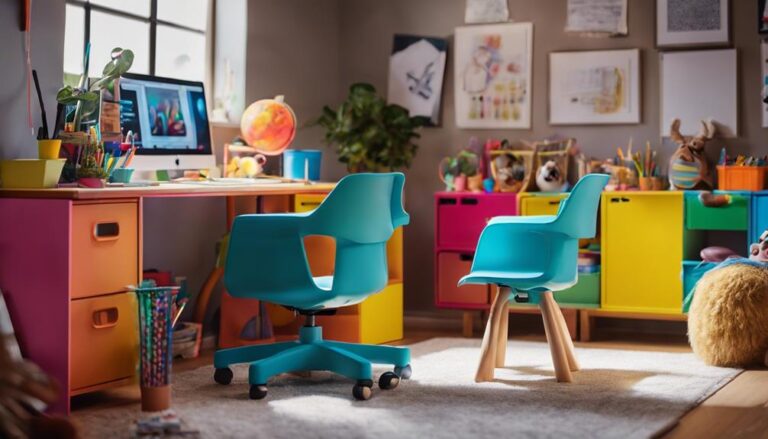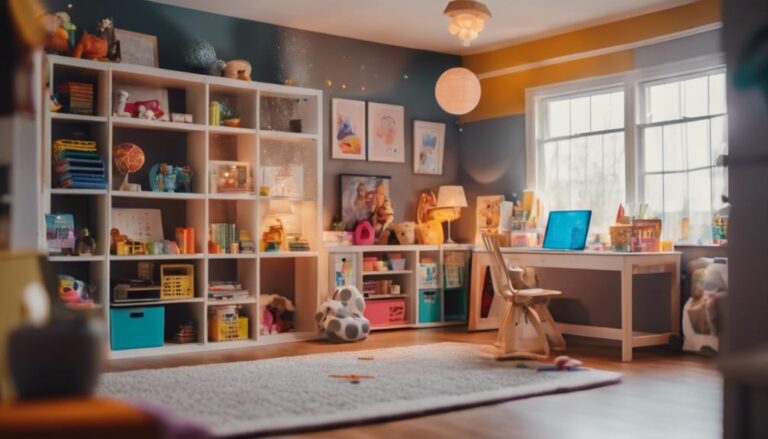Creating a child-friendly remote workspace means prioritizing safety, organization, and engagement. I guarantee the area is secure by childproofing and installing safety measures like gates and covers. The workspace is divided into clear zones for work and play, with easy-access storage for toys. Comfortable, ergonomic furniture supports growing bodies. I include educational tools and quiet zones to enhance learning and concentration. Flexible scheduling allows me to align work hours with family needs. By implementing these steps, I create a productive and nurturing environment. There's more to know, especially about optimizing such spaces for developmental benefits.
Key Takeaways
- Utilize safety measures like securing electrical outlets and installing safety gates to ensure a child-safe environment.
- Implement organized storage solutions such as bins and shelves to keep the workspace clutter-free and accessible.
- Designate a play area with non-toxic, age-appropriate toys and maintain visibility for easy supervision.
- Create quiet zones with ergonomic furniture to support proper posture and encourage focused, uninterrupted work time.
- Incorporate flexible scheduling to align work hours with family needs, enhancing work-life balance and productivity.
Safety Measures
Implementing robust safety measures is vital for creating a secure and child-friendly remote workspace. I guarantee that security cameras are installed for parental monitoring, which keeps the environment safe.
High sanitation standards are maintained to promote a healthy space for children. Regular safety checks and audits are conducted to uphold these safety protocols.
Restricting access to strangers is essential; only trusted individuals can enter the workspace. Establishing emergency procedures allows us to address safety concerns promptly and effectively.
Organized Layout
In creating an organized layout, I focus on clear desk areas that separate work and play zones, ensuring each has purpose and functionality.
Using accessible storage solutions like bins and shelves keeps everything within reach yet neatly stowed away.
Additionally, integrating kid-safe equipment seamlessly into the workspace promotes a harmonious and productive environment for both work and childcare.
Clear Desk Areas
A well-organized desk area is vital for maintaining productivity and reducing distractions in a child-friendly remote workspace. By creating clear, structured desk areas, I can designate specific zones for work and play, greatly enhancing work-life balance.
This organized layout allows me to concentrate better and switch seamlessly between professional tasks and childcare responsibilities. A clutter-free desk not only fosters focus for both parents and children but also cultivates a sense of calm and order.
Research shows that a tidy workspace boosts productivity, making it easier to manage multiple roles effectively. Embracing an innovative approach to clear desk areas guarantees a harmonious environment where everyone can thrive, balancing work demands with family needs.
Accessible Storage Solutions
Efficient storage solutions like labeled bins, shelves, and drawers make it simple to keep our workspace organized and accessible for both me and my child. These solutions not only minimize clutter but also promote a sense of order, essential for a child-friendly remote workspace.
Vertical storage options maximize space efficiency, ensuring everything has its place.
To encourage independence and organization, I focus on:
- Labeled bins for easy identification.
- Shelves at child-height for accessible reach.
- Drawers with dividers to categorize supplies.
- Pegboards for vertical storage of small items.
- Transparent containers to quickly see contents.
These innovative storage solutions aren't just practical but also foster a structured environment, enabling my child to thrive in a well-organized space.
Kid-Safe Equipment
Keeping our workspace organized with safe, child-friendly equipment not only minimizes hazards but also fosters a secure and productive environment for both work and play.
In a child-friendly workspace, utilizing kid-safe equipment is essential. I guarantee all cords are neatly tucked away and use furniture with rounded edges to prevent injuries. Additionally, I invest in storage solutions that are both accessible and secure, like lockable drawers for potentially hazardous items.
This organized layout not only keeps the area clutter-free but also allows smooth shifts between work and play.
Prioritizing safety and accessibility in our setup enhances productivity and comfort, creating an innovative and functional remote workspace for the entire family.
Designated Play Area
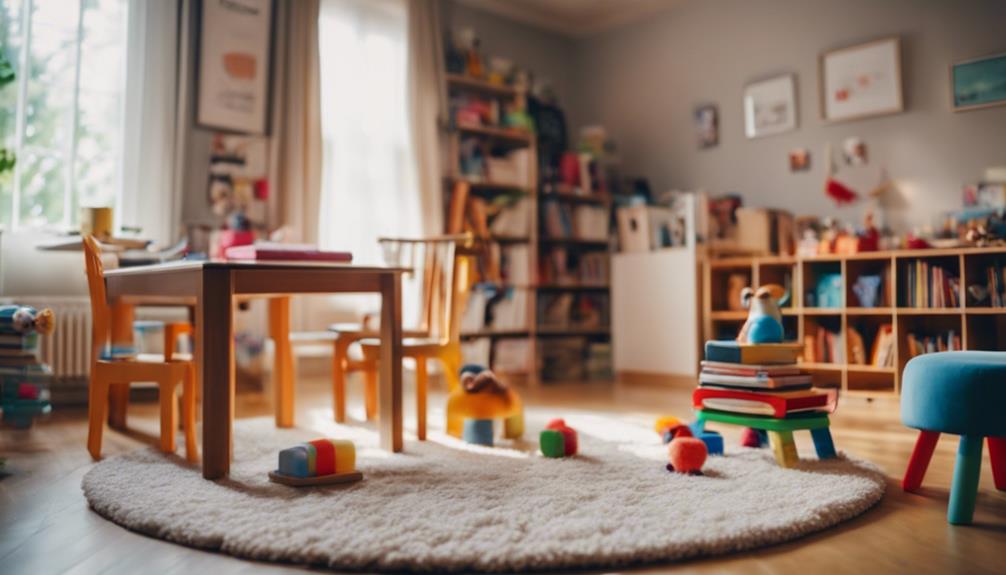
Establishing a designated play area in a child-friendly remote workspace is crucial for maintaining clear boundaries between professional duties and childcare. A well-thought-out play area allows my children to engage in independent activities while I focus on work. The space should be safe, stimulating, and easily accessible, ensuring that it promotes creativity and minimizes distractions.
To optimize the play area, consider these key elements:
- Safety: Guarantee all toys and furniture are non-toxic and child-friendly.
- Stimulation: Include a variety of age-appropriate, educational toys.
- Accessibility: Position the play area within your sightline to maintain supervision.
- Organization: Use bins and shelves to keep the area tidy.
- Comfort: Add soft mats or rugs for a cozy atmosphere.
This balance fosters both productivity and a nurturing environment.
Quiet Zones
While the designated play area keeps my children entertained, creating quiet zones is equally important for maintaining a focused work environment. Quiet zones provide a dedicated space for concentration, ensuring productivity for both parents and children.
By setting up these areas, I can maintain a professional atmosphere during work hours, free from distractions. These spaces are essential for uninterrupted work time, allowing my children to engage in independent activities without disturbing my workflow. This balance is critical for effectively managing work and childcare responsibilities.
Research shows that designated quiet zones in a workspace enhance focus and efficiency, making them an indispensable component of a child-friendly remote workspace. Prioritizing these spaces fosters a harmonious, productive environment.
Educational Tools

Leveraging educational tools in a child-friendly remote workspace enriches my children's learning experiences and supports their intellectual growth. By integrating interactive learning apps, educational websites, and virtual tutoring programs, I can create a dynamic and engaging environment. These tools cater to various subjects and learning styles, guaranteeing that my kids remain curious and motivated.
Educational tools offer numerous benefits:
- Interactive Apps: Make learning fun and engaging.
- Educational Websites: Provide access to a wealth of information.
- Virtual Tutoring: Offers personalized guidance and support.
- Diverse Subjects: Cover everything from math to language arts.
- Age-Appropriate Content: Tailored to different developmental stages.
Incorporating these tools into our remote workspace secures continuous intellectual development and a love for learning.
Childproofing Essentials
To create a truly effective child-friendly remote workspace, it's necessary to prioritize childproofing essentials to guarantee safety and peace of mind. Securing electrical outlets, covering sharp corners, and installing safety gates are foundational steps. Locking cabinets and drawers, anchoring heavy furniture, and using door stoppers further enhance safety. For a more thorough approach, consider baby-proofing items like cabinet locks, stove knob covers, and window guards.
Here's a quick reference:
| Essential | Purpose |
|---|---|
| Electrical outlet covers | Prevent electrical hazards |
| Safety gates | Restrict access to dangerous areas |
| Furniture straps | Secure heavy items |
Innovative solutions like cordless window blinds and toilet locks add extra layers of protection. These childproofing essentials ensure a workspace that lets you work productively while your child explores safely.
Comfortable Seating
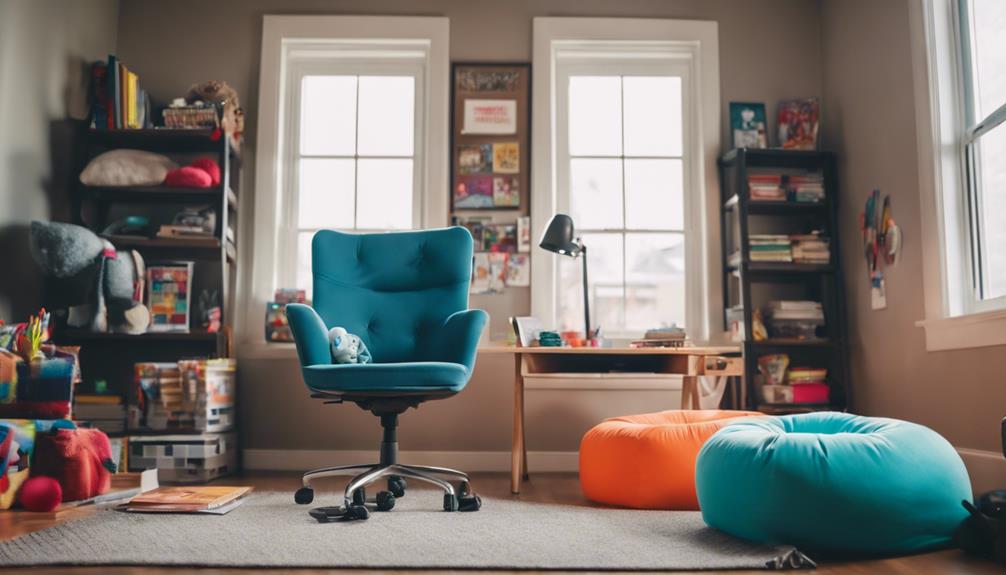
When setting up a child-friendly remote workspace, I prioritize ergonomic chair options to support proper posture and prevent discomfort.
Adjustable desk heights are also essential, as they allow the workspace to grow with the child, ensuring ideal comfort.
Research shows that ergonomically designed furniture can greatly reduce the risk of developing musculoskeletal issues in children.
Ergonomic Chair Options
Investing in an ergonomic chair is crucial for creating a comfortable and health-conscious remote workspace. It provides the necessary support to prevent back pain and improve posture during long hours of sitting. These chairs are designed with features that cater to the unique needs of remote workers, especially children.
High-quality materials like breathable mesh and cushioning guarantee both durability and comfort.
Key features of ergonomic chairs include:
- Adjustable height to accommodate different body types.
- Lumbar support to maintain the natural curve of the spine.
- Armrests to reduce strain on shoulders and neck.
- Swivel base for easy movement and access to different workspace areas.
- Tilt mechanism to promote dynamic sitting and better blood circulation.
These elements collectively enhance productivity and well-being.
Adjustable Desk Heights
While an ergonomic chair plays a fundamental role in a child's remote workspace, an adjustable desk height is equally important for maintaining comfort and proper posture. Research shows that customizable desk heights cater to children of different ages and sizes, promoting proper posture and reducing musculoskeletal issues.
Adjustable desks aren't just about comfort; they also enhance focus and concentration, key for effective learning and play. As children grow, these desks adapt, guaranteeing long-term usability.
Storage Solutions
Effective storage solutions play a crucial role in creating a child-friendly remote workspace that strikes a balance between productivity and play. Integrating smart storage options can significantly improve both functionality and organization. Utilizing low bookcases with baskets offers easy access to toys and supplies, promoting independence and reducing clutter. Organizing toys into categorized baskets helps maintain a tidy environment, while furniture with built-in storage enhances space efficiency.
Essential items should be strategically placed within reach, utilizing bins, shelves, and cabinets. Implementing these storage solutions can lead to a more organized and efficient workspace. Additionally, incorporating a daily cleanup system ensures that the workspace remains inviting and conducive to productivity.
Here are some key tips to consider:
- Use low bookcases with baskets for easy access.
- Categorize toys into specific baskets.
- Incorporate furniture with built-in storage.
- Keep essential items within arm's reach.
- Implement a daily cleanup system.
Interactive Activities
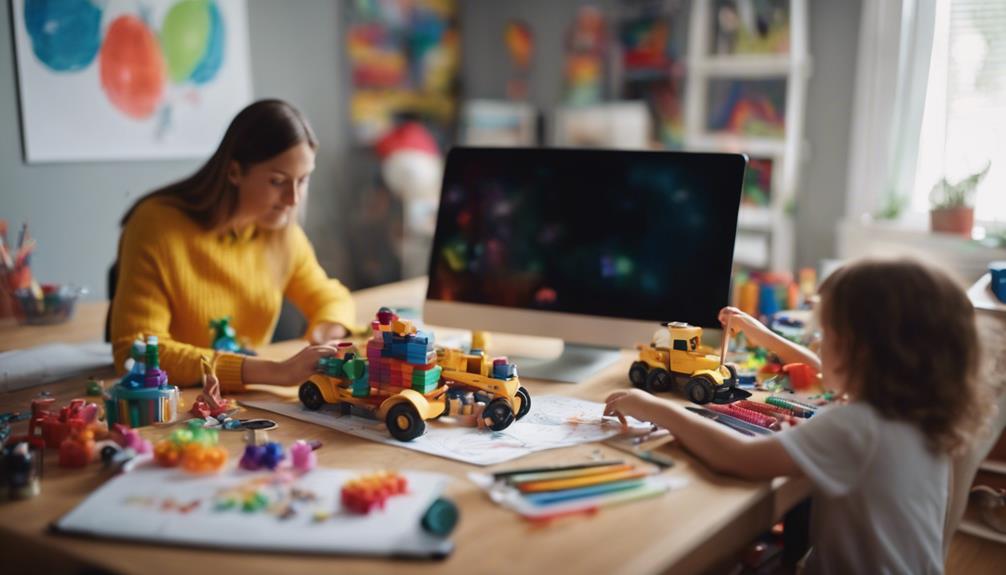
Interactive activities are essential in a child-friendly remote workspace to keep children engaged and promote their cognitive and social development. Incorporating educational games, storytelling sessions, and arts and crafts projects can make a world of difference. These activities not only entertain but also stimulate creativity and cognitive skills. Virtual classes, workshops, and interactive online platforms can cater to different age groups and interests, providing a well-rounded experience.
Here's a breakdown of potential interactive activities:
| Activity Type | Benefits | Suitable Age Groups |
|---|---|---|
| Educational Games | Enhances problem-solving | 5-12 |
| Storytelling Sessions | Boosts language skills | 3-10 |
| Arts and Crafts Projects | Fosters creativity | 4-12 |
| Virtual Classes | Offers structured learning | 6-15 |
| Interactive Online Platforms | Promotes social interaction | 5-14 |
Flexible Scheduling
Balancing work and childcare becomes more manageable when parents can tailor their schedules to fit their children's routines and needs. Flexible scheduling is crucial in a child-friendly remote workspace. It empowers parents to optimize productivity and job satisfaction by working during periods that align with their family dynamics. Research shows that parents who adjust their work hours effectively can better accommodate their children's activities, fostering a healthy work-life balance.
Here are key benefits of flexible scheduling:
- Enhances productivity by aligning work hours with peak personal efficiency.
- Reduces stress associated with rigid work hours.
- Promotes a healthier family dynamic.
- Increases job satisfaction due to better work-life integration.
- Allows for more quality time with children.
Innovative workplaces embracing flexible scheduling will likely see happier, more productive employees.
Frequently Asked Questions
How Can I Make My Office Kid Friendly?
To make my office kid-friendly, I'd integrate interactive decor, designated play areas, and child-friendly furniture. I'd create quiet zones, art corners, and reading nooks. Research shows this balance enhances productivity and developmental engagement for both of us.
How Do You Design Safe Spaces for Children?
When designing safe zones for children, I focus on child-friendly, sturdy furniture, childproofing outlets, securing heavy items, and creating play areas with soft flooring. I regularly inspect for hazards, ensuring a continually secure, innovative environment.
How Can I Work Remotely With My Child at Home?
I manage remote work by integrating interactive activities for my child, ensuring a shared workspace with child-friendly furniture, and sticking to a schedule that balances dedicated work time and quality engagement. Research shows this boosts productivity and development.
How Can I Balance My Work From Home With Kids?
Balancing work from home with kids requires effective time management. I create a structured schedule, set clear boundaries, and plan engaging activities for my children. Open communication with my family and employer guarantees a harmonious work-life balance.
Conclusion
Creating a child-friendly remote workspace isn't just about productivity; it's about balance.
I remember a colleague who turned her home office into a dual-functional space. She used a small corner for her work and set up a mini art studio for her kids. It worked wonders!
By integrating safety, organization, and flexibility, we can foster both professional growth and child development.
With the right planning, your workspace can genuinely cater to everyone's needs.

